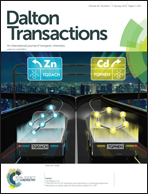Solvent effect-driven assembly of W/Cu/S cluster-based coordination polymers from the cluster precursor [Et4N][Tp*WS3(CuBr)3] and CuCN: isolation, structures and enhanced NLO responses†
Abstract
We herein describe a coordination polymer system built upon the reactions of a W/Cu/S cluster precursor [Et4N][Tp*WS3(CuBr)3] (1, Tp* = hydridotris(3,5-dimethylpyrazol-1-yl)borate) with three equivalents of CuCN through solvent modulation. Four coordination polymers, namely, [Tp*WS3Cu3(μ3-DMF)(CN)3Cu(Py)] (2), [Tp*WS3Cu3(μ3-DMF)(CN)3Cu] (3), [Tp*WS3Cu3(μ3-DMF)(CN)3Cu]·4aniline (4·4aniline) and [Tp*WS3Cu3(μ3-DMF)(CN)3Cu]·2(DMF)0.5 (5·2(DMF)0.5), are isolated in different solvent systems and characterized by means of elemental analysis, FT-IR, UV-Vis, ESI-MS and single-crystal X-ray diffraction. Compounds 2–5 feature μ3-DMF association with the nest-shaped [WS3Cu3] cluster cores, yielding cubane-type [WS3Cu3O] clusters which are further linked to single Cu(I) ions through CN bridges to provide 1D or 2D structures. Compounds 3–5 have identical chemical compositions in their main fragments but with distinctively different structural features, and are therefore topological isomers. Compound 2 has a ladder-type structure in which the side rails contain alternately linked cluster cores and Cu(I) ions. Compound 3 has a 2D (6,3) network with alternately arranged cluster cores and Cu(I) ions. Both 4 and 5 have 2D structures with 4·82 topology. In 4, a pair of cluster cores and Cu(I) ions form a 4-membered ring which is further linked to four equivalent rings through four CN ligands via a cluster core-to-Cu arrangement; while in the structure of 5, the same 4-membered rings as those in 4 are extended to equivalent rings via a cluster core-to-cluster and Cu-to-Cu arrangement. The hyperpolarizabilities (γ) of the polymeric networks exhibit an enhancement of more than 10 times compared to their parent cluster, 1.
![Graphical abstract: Solvent effect-driven assembly of W/Cu/S cluster-based coordination polymers from the cluster precursor [Et4N][Tp*WS3(CuBr)3] and CuCN: isolation, structures and enhanced NLO responses](/en/Image/Get?imageInfo.ImageType=GA&imageInfo.ImageIdentifier.ManuscriptID=C4DT02725F&imageInfo.ImageIdentifier.Year=2015)

 Please wait while we load your content...
Please wait while we load your content...